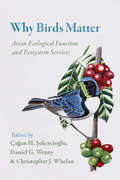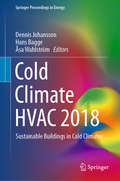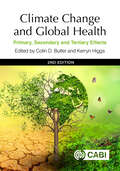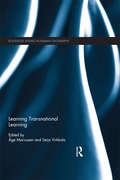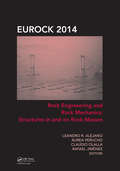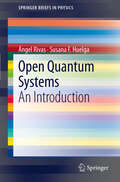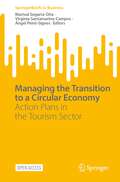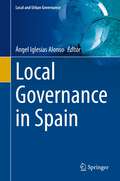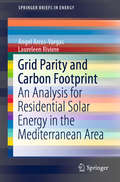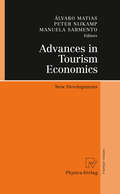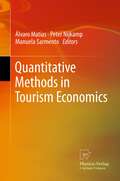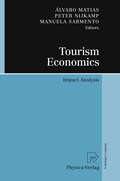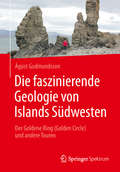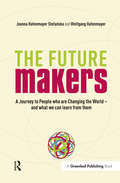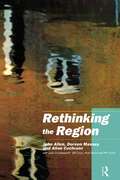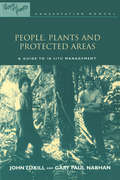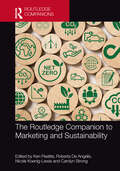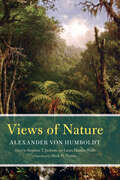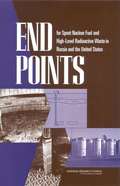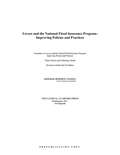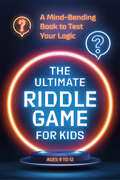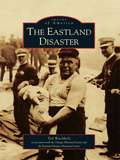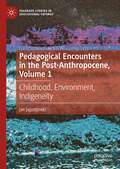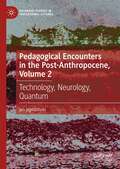- Table View
- List View
Why Birds Matter: Avian Ecological Function and Ecosystem Services
by Christopher J. Whelan Daniel G. Wenny Çağan H. Şekercioğlu, Daniel G. Wenny, and Christopher J. WhelanFor over one hundred years, ornithologists and amateur birders have jointly campaigned for the conservation of bird species, documenting not only birds’ beauty and extraordinary diversity, but also their importance to ecosystems worldwide. But while these avian enthusiasts have noted that birds eat fruit, carrion, and pests; spread seed and fertilizer; and pollinate plants, among other services, they have rarely asked what birds are worth in economic terms. In Why Birds Matter, an international collection of ornithologists, botanists, ecologists, conservation biologists, and environmental economists seeks to quantify avian ecosystem services—the myriad benefits that birds provide to humans. The first book to approach ecosystem services from an ornithological perspective, Why Birds Matter asks what economic value we can ascribe to those services, if any, and how this value should inform conservation. Chapters explore the role of birds in such important ecological dynamics as scavenging, nutrient cycling, food chains, and plant-animal interactions—all seen through the lens of human well-being—to show that quantifying avian ecosystem services is crucial when formulating contemporary conservation strategies. Both elucidating challenges and providing examples of specific ecosystem valuations and guidance for calculation, the contributors propose that in order to advance avian conservation, we need to appeal not only to hearts and minds, but also to wallets.
Cold Climate HVAC 2018: Sustainable Buildings in Cold Climates (Springer Proceedings in Energy)
by Dennis Johansson Hans Bagge Åsa WahlströmThis volume presents the proceedings of the 9th Cold Climate HVAC conference, which was held in Kiruna, Sweden in 2018. The conference highlighted key technologies and processes that allow scientists, designers, engineers, manufacturers and other decision makers in cold climate regions to achieve good indoor environmental quality (IEQ) with a minimum use of energy and other resources. The conference addressed various technical, economic and social aspects of buildings and HVAC systems in new and renovated buildings. This proceedings volume gathers peer-reviewed papers by a diverse and international range of authors and showcases perspectives and practices in cold climate building design from around the globe. The following major aspects, which include both fundamental and theoretical research as well as applications and case studies, are covered: (1) Energy and power efficiency and low-energy buildings; (2) Renovating buildings; (3) Efficient HVAC components; (4) Heat pumps and geothermal systems; (5) Municipal and city energy systems; (6) Construction management; (7) Buildings in operation; (8) Building simulation; (9) Reference data; (10) Transdisciplinary connections and social aspects; (11) Indoor environments and health; (12) Moisture safety and water damage; (13) Codes, regulations, standards and policies; and (14) Other aspects of buildings in cold climates.
Climate Change and Global Health: Primary, Secondary and Tertiary Effects
by Richard Dennis Mary Robinson Pei Yu Robert White Philip Weinstein Andy Morse Peter Stoett Ruth Irwin Tari Haahtela Tilman Ruff Martin McKee Stewart Sutherland Tord Kjellstrom Cyril Caminade Dr Nicholas H. Ogden Will Steffen Glen Mola Ågot Aakra Khaled Abass Robyn Alders Kofi Amegah Janetrix Hellen Amuguni Gulrez Shah Azhar Katherine Barraclough Barbara Berner Alex Blum Justin Borevitz Menno Bouma Devin C. Bowles Mark Braidwood Anne Lise Brantsæter Katrina Charles Fiona Charlson Moumita Sett Chatterjee Matthew Chersich Rebecca Colvin Namukolo Covic Christopher B Daniels Cybele Dey Hubert Dirven Yuming Guo Ivan C Hanigan Andrew Harmer Budi Haryanto Dr Kerryn Higgs Susanne Hyllestad Christine Instanes Ollie Jay Solveig Jore Ke Ju Marit Låg Jason Kw Lee Shanshan Li Irakli Loladze Rosemary A. McFarlane Helle Margrete Meltzer Juliet Nabyonga-Orem Johan Øvrevik Rebecca Patrick Rezanur Rahaman Delia Randolph Shilpa Rao Arja Rautio Subhashis Sahu Jonathan Samet Photini Sinnis Julie P Smith Jessica Stanhope Cathrine Thomsen Collin Tukuitonga May Van Schalkwyk Gro Dehli Villanger Sue Wareham Bo Wen Kirsty Wild Kate Wingett Alistair Woodward Caradee Y. Wright Yao WuThere is increasing understanding that climate change will have profound, mostly harmful effects on human health. In this authoritative book, international experts examine long-recognized areas of health concern for populations vulnerable to climate change, describing effects that are both direct, such as heat waves, and indirect, such as via vector-borne diseases. Set in a broad international, economic, political and environmental context, this unique book expands these issues by reviving and championing a third ('tertiary') category of longer term impacts on global health: famine, population dislocation, conflict and collapse. This edition has an expanded foundation, with new chapters discussing nuclear war, population and limits to growth, among others. This lively yet scholarly resource explores all these issues, finishing with a practical discussion of avenues to reform. As Mary Robinson, former UN High Commissioner for Human Rights, states in the foreword: 'Climate change interacts with many undesirable aspects of human behaviour, including inequality, racism and other manifestations of injustice. Climate change policies, as practised by most countries in the global North, not only interact with these long-standing forms of injustice, but exemplify a new form, of startling magnitude.' The book is dedicated to Tony McMichael, Will Steffen and Maurice King. This book will be invaluable for students, post-graduates, researchers and policy-makers in public health, climate change and medicine.
Learning Transnational Learning (Routledge Studies in Human Geography)
by Åge Mariussen Seija VirkkalaSystems of innovation that are conducted within national borders can preserve inefficient solutions and prevent development. This has led to a feeling that transnational learning strategies are more and more desirable. In practice, the field of transnational learning has been dominated by various policy-making institutions, such as the OECD and European Union, working through different types of policy instruments and programs such as structural funds, open methods of coordination, as well as international research institutions and networks set up by cooperating national governments working on comparative analysis, benchmarking and indicators. This book lays out a set of methods which can further enhance the experience of transnational learning, starting from the sociological ideas promoted by Charles Sabel of learning through monitoring, and by Marie Laure Djelic and others of the “translation” of experiences between different countries. Case studies and examples are collected from three fields: industrial development, tourism and local government.
Rock Engineering and Rock Mechanics: Structures in and on Rock Masses
by Áurea Perucho Rafael Jiménez Claudio Olalla Leandro R. AlejanoRock Engineering and Rock Mechanics: Structures in and on Rock Masses covers the most important topics and state-of-the-art in the area of rock mechanics, with an emphasis on structures in and on rock masses. The 255 contributions (including 6 keynote lectures) from the 2014 ISRM European Rock Mechanics Symposium (EUROCK 2014, Vigo, Spain, 27-29 Ma
A Trajectory Description of Quantum Processes. II. Applications: A Bohmian Perspective (Lecture Notes in Physics #831)
by Ángel S. Sanz Salvador Miret-ArtésTrajectory-based formalisms are an intuitively appealing way of describing quantum processes because they allow the use of "classical" concepts. Beginning as an introductory level suitable for students, this two-volume monograph presents (1) the fundamentals and (2) the applications of the trajectory description of basic quantum processes. This second volume is focussed on simple and basic applications of quantum processes such as interference and diffraction of wave packets, tunneling, diffusion and bound-state and scattering problems. The corresponding analysis is carried out within the Bohmian framework. By stressing its interpretational aspects, the book leads the reader to an alternative and complementary way to better understand the underlying quantum dynamics.
Open Quantum Systems
by Ángel Rivas Susana F. HuelgaIn this volume the fundamental theory of open quantum systems is revised in the light of modern developments in the field. A unified approach to the quantum evolution of open systems is presented by merging concepts and methods traditionally employed by different communities, such as quantum optics, condensed matter, chemical physics and mathematical physics. The mathematical structure and the general properties of the dynamical maps underlying open system dynamics are explained in detail. The microscopic derivation of dynamical equations, including both Markovian and non-Markovian evolutions, is also discussed. Because of the step-by-step explanations, this work is a useful reference to novices in this field. However, experienced researches can also benefit from the presentation of recent results.
Managing the Transition to a Circular Economy: Action Plans in the Tourism Sector (SpringerBriefs in Business)
by Virginia Santamarina-Campos Marival Segarra-Oña Ángel Peiró-SignesThis open access book presents an interdisciplinary analysis of the current status of the circular economy in the tourism sector. This book is presented from the perspective of researchers, policymakers, and industry. Specially aimed at companies in the tourism sector, the book offers valuable information in the field of circular economy, promoting the design/redesign of processes and products. The authors emphasize promoting the development and application of new knowledge and technologies to promote innovation in processes, products, services, and business models, promoting public-private collaboration. With contributions from experts representing varied interests throughout the tourism industry, the book encourages the involvement of economic and social agents to raise awareness of current environmental, economic, and technological challenges.
Local Governance in Spain (Local and Urban Governance)
by Ángel Iglesias AlonsoThe book addresses in detail local governance in Spain. In recent decades, local governments in Europe have increasingly found themselves under pressure from a multitude of new challenges, such as demographic change, climate change, fiscal austerity policies, digitization, the demand for more citizen participation in local affairs, and the migration crisis in some of them, to name just a few. Consequently, a wave of political and administrative reforms to address these challenges, pressures and problems, has changed local governance in many countries. In part, these changes were the result of reform policies introduced by national and state governments, often triggered by austerity policies, which has become an overwhelming reality for Spanish local governments that have been forced to introduce innovations in local governance. This book aims to give an account of these innovations in local governance in Spain.This book considers the local political-administrative structure in its dimensions, focusing on the analysis of its party system, electoral competition and political behavior in the local arena, as well as on local finances, all of which are determining elements in urban and rural governance processes. On the occasion of the recent crisis unleashed by Covid-19, the book will also deal with local governance in crisis situations. The book will also contextualize local governance processes in Spain in relation to the trends in local governance observed in other European countries.
Grid Parity and Carbon Footprint: An Analysis For Residential Solar Energy In The Mediterranean Area (SpringerBriefs in Energy)
by Ángel Arcos-Vargas Laureleen RiviereThis book analyses the economic and environmental aspects of installing photovoltaic facilities for residential electricity users and determines whether the installation of photovoltaic units “behind the meter” makes sense, and if so, the best economic size to install. It explores the use of photovoltaic capacity to meet electricity requirements by generating enough for immediate use without feeding surplus electricity into the grid and without using storage. The authors illustrate this approach by examining various power photovoltaic capacities in locations such as Marseille, Madrid and Seville, which use hourly demand data provided by smart meters. They also show the possibility of developing energy self-consumption compatible with the operation of the network, making use of information from smart meters. Discussing how photovoltaic facilities are profitable from both an economic and an environmental point of view, this book is a valuable resource for researchers and private investors. It is also of interest to practitioners and academics, as the results presented are of importance for the near future.
Advances in Tourism Economics: New Developments
by Peter Nijkamp Manuela Sarmento Álvaro Matias'Advances in Tourism Economics' follows his predecessor 'Advances in Modern Tourism Research' (2007) in providing a thorough assessment of state-of-the-art economic research in this rapidly developing field. The authors start by analyzing the recent upsurge of model-based economic research in the field, which builds on powerful tools in quantitative economics, such as discrete choice models, social accounting matrices, data envelopment analyses, impact assessment models or partial computable equilibrium models including environmental externalities. The volume originates from this novel research spirit in the area and aims to offer an attractive collection of operational research tools and approaches. It forms an appealing record of modern tourism economics and positions the field within the strong tradition of quantitative economic research, with due attention for both the demand and supply side of the tourism sector, including technological and logistic advances.
Quantitative Methods in Tourism Economics
by Peter Nijkamp Manuela Sarmento Álvaro MatiasTourism economics is partly based on established principles from the economics discipline, but it also incorporates elements from sociology, psychology, organization theory and ecology. It has over the years turned into an appealing multi-disciplinary oriented approach to the understanding of the impacts of leisure time in a modern society, including cultural heritage, sustainable quality of life, and industrial organization of the hospitality industry. The increasing dynamics in the tourist industry and its worldwide effects will continue to attract the attention of both the research and the policy sector in the years to come. Rather than speculating on non-observed facts, there is a clear need for evidence-based research in order to map out the complex dynamics of the tourist industry. The present volume comprises novel studies - mainly of a quantitative-analytical nature - on the supply, demand and contextual aspects of modern tourism. It contains a sound mix of theory, methodology, policy and case studies on various tourism issues in different parts of the world.
Tourism Economics: Impact Analysis
by Peter Nijkamp Manuela Sarmento Álvaro MatiasThe assessment of local, regional or national impacts of an influx of tourists - of different kind and origin - has in recent years become a new challenge for economics research in the tourism sector. There is a clear need to develop solid methodologies through which the socio-economic impacts of tourism can be assessed. Tourism impact assessment - as a systematic approach to the estimation of socio-economic effects of tourism on relevant parts of the economy - has become a timely response to the need for appropriate information for stakeholders, both public and private. The present volume brings together a set of recent impact studies - of both a theoretical-methodological and an applied policy-oriented nature - , which have been selected on the basis of their originality or novel contribution to the research in this field.
Die faszinierende Geologie von Islands Südwesten
by Ágúst Gudmundsson Sonja PhilippSteigen Sie mit diesem einzigartigen Buch in die faszinierende Geologie von Islands Südwesten ein. Entdecken Sie entlang von fünf bekannten Touren die geologische Vielfalt dieser Insel: (1) Der berühmte "Goldene Ring" (Golden Circle), (2) Täler und Berge des Fjordes Hvalfjördur, (3) die einzigartige Landschaft und Geothermalfelder des Hengill-Vulkans, (4) Explosionskrater, Vulkanspalten und Lavafelder der Reykjanes-Halbinsel und (5) Vulkane (Hekla, Eyjafjallajökull, Katla), Wasserfälle, Sanderflächen und Basaltsäulen Südislands. Der Goldene Ring ermöglicht, die Kräfte unseres Planeten auf einzigartige Weise zu beobachten und zu verstehen. Diese Kräfte bewegen die tektonischen Platten, reißen die Kruste auf und führen zu Erdbeben, Vulkanausbrüchen, Flussbetten und Wasserfällen sowie Wärmequellen für heiße Quellen und Geysire. Der Goldene Ring umfasst Thingvellir, bekannt für Rifting und Erdbebenbrüche, die heißen Quellen von Geysir, den Wasserfall Gullfoss und den Vulkankrater Kerid. Dieses Buch wendet sich in erster Linie an interessierte Laien ohne geowissenschaftliche Vorkenntnisse. Aus diesem Grund wurde leicht verständliche Sprache gewählt, die mit wenigen geologischen Fachbegriffen auskommt. Ein ausführliches Glossar liefert die Erklärung zu den einzelnen Begriffen. Auch für Geowissenschaftler ist dieses Buch wegen seiner über 240 Abbildungen – überwiegend Fotografien – von Interesse.
The Future Makers: A Journey to People who are Changing the World – and What We Can Learn from Them
by joanna Hafenmayer wolfgang HafenmayerAre you looking for sense and meaning in your work? Would you like to be successful but expect more in the way of reward and fulfilment than just a paycheque? The Future Makers offers 23 encouraging responses to these questions. It tells the diverse stories of people from around the world who have made a sustainable mark on the world through their careers: from an American financial market specialist to tree planters in Africa; from Japanese environmental experts to dancers in Argentina. The Future Makers are people who make the world a better, more beautiful and livable place for current and coming generations. The Hafenmayers present these inspiring stories in an accessible, entertaining and thoughtful way. But they also do far more. The book presents a toolkit on how you can forge a career that has a positive impact on the world. This step-by-step process has already had a life-changing impact on readers of the original German edition. It is packed with helpful suggestions for personal development and reorientation – for a work life that will make you happier and deeply satisfied. The Future Makers takes you on a journey to people whose values and visions aren't compartmentalized into corners of their lives. They live their dreams every day. This book will show you how you can do the same.
Rethinking the Region: Spaces of Neo-Liberalism
by John Allen Doreen Massey Allan Cochrane Nick Henry with Julie Charlesworth Gill Court Phil SarreRethinking the Region argues that regions are not simply bounded spaces on a map. This book uses unique research of England during the 1980s to show how regions are made and unmade by social processes. The book examines how new lines of division both social and geographical were laid down as free-market growth and reconstructed this are as a `neo-liberal' region. The authors argue that a more balanced form of growth is possible - within and between regions as well as between social groups. This book shows that to grasp the complexities of growth we must rethink `the region' in time as well as in space.
People, Plants and Protected Areas: A Guide to in Situ Management (People and Plants International Conservation #Vol. 3)
by Gary Paul Nabhan John Tuxill with Elizabeth Drexler Michael HathawayConservation of plant resources is often focused on seed banks and botanical gardens. However, the two authors of this volume present a comprehensive conservation strategy that complements this ex-situ approach with practical guidance on in-situ management and conservation of plant resources. The book aims to facilitate better management of protected areas and to illustrate new approaches to conservation of plants within their landscapes. It draws on concepts from forestry, the agricultural sciences, anthropology, ethnology and ethnobotany and should be useful to practitioners, academics and policy-makers.
The Routledge Companion to Marketing and Sustainability (Routledge Companions in Marketing, Advertising and Communication)
by Linda Hendry James Cronin Peter Wells Matthew Gorton Cesare Amatulli Matteo De Angelis Fred Lemke Fiona Spotswood Roberta De Angelis Frank-Martin Belz Ken Peattie Carolyn Strong Vesna Zabkar Brian P. McCullough Oksana Mont Nicole Koenig-Lewis Klement Podnar Ann-Marie Kennedy Ronald Duncan Maria G. Piacentini Julie V. Stanton John Thøgersen Ben Wooliscroft Diane M. Phillips Steve Muylle Myriam Ertz Giancarlo Ianulardo Jessica Aschemann-Witzel Carmela Bosangit Ronika Chakrabarti Prabirendra Chatterjee Andrea Collins Flávia L. Consoni Laurel A. Cook Gabriel L. Coutinho Alba D’Aniello Patrick Elf Alexandra Ganglmair-Wooliscroft Urša Golob Deirdre Guion Peoples Charlotte Hadley Sophie I. Hallstedt John G. Hardy Ola Isaksson Amy Isham Ariadne Kapetanaki Joya A. Kemper Lee, Michael S.W. Will Low Sheila Malone Alexandre Metreveli Clare Mumford Jason Keith Phillips Rumen Pozharliev Behzad Samii Jesko Schulte Alex Skandalis Alison F. Stowell Ulla-Maija Sutinen van Dun, Desirée H. Savita Verma David Von Berlepsch George Yao Quenum, GautierThis state-of-the-art handbook provides a comprehensive review of recent research and academic thought on the relationship between marketing and sustainability. It combines a ‘micro-marketing’ approach considering how to market more sustainable goods and services, with a more critical perspective considering the implications of our marketing systems for the future of the planet and humankind. It also balances a traditional socio-economic perspective on marketing with a physical systems perspective considering how the consequences of our consumption and production systems play out over time and space.Bringing together a range of leading international experts from more than a dozen countries, this unique collection addresses both the environmental side of the sustainability agenda, through topics such as product development, packaging and circular economy initiatives, and its social side through topics such as fair trade marketing, bottom-of-the-pyramid initiatives and marketing ethics. A range of key market contexts are discussed including food, mobility, tourism, luxury consumption and sports along with important developments in the field around social marketing, sustainable lifestyles, new information technologies and the need for better marketing of sustainability.Exploring how marketing can meet the challenge of the transition towards a more sustainable economy and a fairer society, this unique volume will be welcomed by researchers, students and practitioners from a variety of fields including marketing, business ethics, sociology and environmental studies.Chapter 23 of this book is freely available as a downloadable Open Access PDF at http://www.taylorfrancis.com under a Creative Commons Attribution (CC BY) 4.0 license.
Views of Nature
by Laura Dassow Walls Alexander Von Humboldt translated by Mark W. Person edited by Stephen T. JacksonPurchase of this book includes free trial access to www. million-books. com where you can read more than a million books for free. This is an OCR edition with typos. Excerpt from book: Modern views on the mountain systems of the two American peninsulas. Chains, which have a direction from S. W. to N. E. , in Brazil and in the Atlantic portion of the United States of North America. Depression of the Province of Chiquitos; ridges as watermarks between the Guapor6 and Aguapehi in 15 and 17 south lat. , and between the fluvial districts of the Orinoco and Eio Negro in 2 and 3 north lat. ?pp. 29-31. Continuation of the Andes-chain north of the isthmus of PanamS through the territory of the Aztecs, (where the Popocatepetl, recently ascended by Capt. Stone, rises to an altitude of 17,720 feet, ) and through the Crane and Rocky Mountains. Valuable scientific investigations of Capt. Fremont. The greatest barometric levelling ever accomplished, representing a profile of the ground over 28 of longitude. Culminating point of the route from the coast of the Atlantic to the South Sea. The South Pass southward of the Wind-River Mountains. Swelling of the ground in the Great Basin. Long disputed existence of Lake Timpanogos. Coast-chain, Maritime Alps, Sierra Nevada of California. Volcanic eruptions. Cataracts of the Columbia River?pp. 31-38. General considerations on the contrast between the configuration of the territorial spaces, presented by the two diverging coast-chains, east and west of the central chain, called the Rocky Mountains. Hypsometric constitution of the Eastern Lowland, which is only from 400 to somewhat more than 600 feet above the level of the sea, and of the arid uninhabited plateau of the Great Basin, from 5000 to more than 6000 feet high. Sources of the Mississippi in Lake Istaca according to Nicollet, whose labours are most meritorious. Native land of the Bisons; their ancient domestication in Northern Mexico asserted by Gomara?pp. 38-42. Retrospectiv. .
END POINTS for Spent Nuclear Fuel and High-Level Radioactive Waste in Russia and the United States
by Committee on End Points for Spent Nuclear Fuel High-Level Radioactive Waste in Russia the United StatesEnd Points for spent Nuclear Fuel and High-Level Radioactive Waste in Russian and the United Statesprovides an analysis of the management of spent nuclear fuel and high-level radioactive waste in Russia and the United States, describing inventories, comparing approaches, and assessing the end-point options for storage and disposal of materials and wastes. The authoring committee finds that despite differences in philosophy about nuclear fuel cycles, Russia and the United States need similar kinds of facilities and face similar challenges, although in Russia many of the problems are worse and funding is less available. This book contains recommendations for immediate and near-term actions, for example, protecting and stabilizing materials that are security and safety hazards, actions for the longer term, such as developing more interim storage capacity and studying effects of deep injection, and areas for collaboration.
Levees and the National Flood Insurance Program
by Committee on Levees the National Flood Insurance Program Improving Policies PracticesThe Federal Emergency Management Agency's (FEMA) Federal Insurance and Mitigation Administration (FIMA) manages the National Flood Insurance Program (NFIP), which is a cornerstone in the U. S. strategy to assist communities to prepare for, mitigate against, and recover from flood disasters. The NFIP was established by Congress with passage of the National Flood Insurance Act in 1968, to help reduce future flood damages through NFIP community floodplain regulation that would control development in flood hazard areas, provide insurance for a premium to property owners, and reduce federal expenditures for disaster assistance. The flood insurance is available only to owners of insurable property located in communities that participate in the NFIP. Currently, the program has 5,555,915 million policies in 21,881 communities3 across the United States. The NFIP defines the one percent annual chance flood (100-year or base flood) floodplain as a Special Flood Hazard Area (SFHA). The SFHA is delineated on FEMA's Flood Insurance Rate Maps (FIRM's) using topographic, meteorologic, hydrologic, and hydraulic information. Property owners with a federally back mortgage within the SFHAs are required to purchase and retain flood insurance, called the mandatory flood insurance purchase requirement (MPR). Levees and floodwalls, hereafter referred to as levees, have been part of flood management in the United States since the late 1700's because they are relatively easy to build and a reasonable infrastructure investment. A levee is a man-made structure, usually an earthen embankment, designed and constructed in accordance with sound engineering practices to contain, control, or divert the flow of water so as to provide protection from temporary flooding. A levee system is a flood protection system which consists of a levee, or levees, and associated structures, such as closure and drainage devices, which are constructed and operated in accordance with sound engineering practices. Recognizing the need for improving the NFIP's treatment of levees, FEMA officials approached the National Research Council's (NRC) Water Science and Technology Board (WSTB) and requested this study. The NRC responded by forming the ad hoc Committee on Levee and the National Flood Insurance Program: Improving Policies and Practices, charged to examine current FEMA treatment of levees within the NFIP and provide advice on how those levee-elated policies and activities could be improved. The study addressed four broad areas, risk analysis, flood insurance, risk reduction, and risk communication, regarding how levees are considered in the NFIP. Specific issues within these areas include current risk analysis and mapping procedures behind accredited and non-accredited levees, flood insurance pricing and the mandatory flood insurance purchase requirement, mitigation options to reduce risk for communities with levees, flood risk communication efforts, and the concept of shared responsibility. The principal conclusions and recommendations are highlighted in this report.
The Ultimate Riddle Game for Kids: A Mind-Bending Book to Test Your Logic
by noneThe ultimate way for kids 9 to 12 to test their logic, unlock their creativity, and improve their lateral thinking skills!Full of mind-bending riddles, challenging brainteasers, math-based questions, and tricky wordplay, The Ultimate Riddle Game for Kids is designed to stimulate your child&’s imagination and improve their problem-solving skills. Irresistibly fun and stealthily educational, this book provides hours of brain-stimulating fun for 9-to-12-year-old kids who love a challenge. An exciting game for competitive kids. Whether your child is playing solo or with a friend, they&’ll head-scratch and laugh their way through these tricky riddles, while competing to get as many correct answers as possible. Quality family time away from screens. Age-appropriate riddles to stump each other around the dinner table, in the car, or any place you share quality time. Build confidence and resilience. The real game &“winner&” is the child who learns to work through tough problems as they gain confidence to try, fail, and pick back up again. Level up the challenge. The riddles in this book progress in difficulty and are organized into three chapters: 1. Quick Hitters: One-to-two-sentence riddles that require lateral thinking and often use wordplay. 2. Math Monsters: Revolving around numbers, some of these riddles involve actual calculations or logical deductions, while others center on wordplay or simply require a new way of thinking about how numbers can relate to each other. 3. Sneaky Stories: Each riddle tells a story and will require more time for kids to think about and work out the problem.
Eastland Disaster, The (Images of America)
by Chicago Historical Society land Disaster Historical Society Ted WachholzMore than 7,000 people living in the Chicago area and Michigan City, Indiana, eagerly anticipated Saturday morning, July 24, 1915. This particular Saturday was going to be anything but a routine summer day. Plans had been carefully made for it to be the social and entertainment event of the year, and for some, a lifetime. The fifth annual midsummer excursion and picnic had been organized by the employees of the Western Electric Company's Hawthorne Works. Thousands of carefree merrymakers would enjoy a festive day including a lovely cruise across Lake Michigan to an awaiting parade and day-long picnic. The day would conclude with an evening cruise back to Chicago. For thousands of hard-working immigrant laborers and their families and friends, it was going to be a day to remember. Instead, the day's scheduled event turned into a tragedy unlike any other. The SS Eastland, while still tied to the wharf, rolled into the Chicago River with more than 2,500 passengers on board. Nearly 850 people lost their lives, including 22 entire families. The ensuing struggle for survival, and the resulting death, heroism, cowardice, greed, and scandal gripped the city of Chicago.
Pedagogical Encounters in the Post-Anthropocene, Volume 1: Childhood, Environment, Indigeneity (Palgrave Studies in Educational Futures)
by jan jagodzinskiThis volume, the first of a two volume set, addresses three major areas in response to the post-Anthropocene: childhood, environment and indigeneity. Each of these areas is broadly addressed in relation to the concerns that have arisen both theoretically and educationally. The author terms these to be encounters as each area presents a particular problematic when addressing the phase change that the planet is undergoing where the anthropogenic labour of global humanity is contributing to climate change, endangering our very existence. There has been a concerted effort to overcome the nature-culture divide in education. The author reviews this development in the first section where there has been a particular emphasis placed on childhood education. In the second section he turns to the pedagogical theories that are attempting to overcome this same divide in environmental and science education. The last section attempts to bring into the conversation the vast literature on Indigeneity and their attempts to revise traditional education to meet these extraordinary times.
Pedagogical Encounters in the Post-Anthropocene, Volume 2: Technology, Neurology, Quantum (Palgrave Studies in Educational Futures)
by jan jagodzinskiAs a follow up to Pedagogical Encounters in the Post-Anthropocene, Volume I, this book addresses three major areas in response to the post-Anthropocene: Technology, Neurology, Quantum. Each of these areas is broadly addressed in relation to the concerns that have arisen both theoretically and educationally. As in Volume I, the author terms these to be encounters as each area presents a particular problematic when addressing the phase change that the planet is undergoing where the anthropogenic labour of global humanity is contributing to climate change, endangering our very existence. Technology in education has been a significant development. There is a concerted effort to review this development placing stress on the rise of learning machines and algorithms. In the second encounter the vast literature on neurology is addressed, especially neurodiversity and the various symptoms that have emerged in the post-Anthropocene era. The last section reviews issues related to quantum theory as this is fundamental to tensions between physics and metaphysics. The volume concludes with the author’s own pedagogical proposal for the future.
